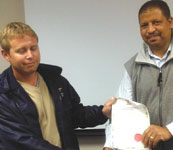

September Technology Evening
Members braved the wet weather on 27 September to attend an informative presentation from Vega Instruments on radar vs ultrasonic level measurement technologies. The presentation was also attended by the SAIMC president Johan Maartens, who encouraged the members to get involved in industry associations and contribute to the success of C&I in the country. He also discussed the projects that the SAIMC is undertaking.
The presenter for the evening was Clint Viviers from Vega in Johannesburg, who started by introducing the concept of ultrasonic measurement and its fundamental theory of operation. Ultrasonic level measurement uses an ultrasound signal at a specific frequency to measure distance. The ultrasonic signal travels at the speed of sound and the time taken for the signal to travel from the sensor and be reflected back is measured. The distance can then be calculated from the formula: distance = speed x time. He also explained that the sensors use piezoelectric transducers to displace the air in front of them to produce the ultrasonic signal. The piezoelectric sensor conversely produces an electric signal from the pressure wave received back. This principle limits the operation of ultrasonic sensors in a vacuum.

Clint discussed various installation guidelines and rules of thumb. Factors that should be carefully considered are installation in noisy areas, temperature compensation, density of the measured product and the surface profile. He then moved over to radar level measurement and discussed the basic theoretical operation of radar level measurement. The main differentiating factor, as compared to ultrasonic, is the type of signal. Radar level measurement uses an electromagnetic signal travelling at the speed of light to measure distance. The principle of operation is similar to ultrasonic sensors using a distance calculation based on a known speed and time of flight. Radar operates optimally on products with a high DK value. The DK value is directly proportional to the conductivity of the material: the higher the conductivity of a substance, the higher the DK. It is therefore important for one to look at the DK of a product prior to choosing radar technology for level measurement. Radar also offers the advantage of having a smaller form factor when compared to ultrasonic sensors.
The Cape Town branch thanks Vega Instruments SA for the continued support.
Branch activities
The planned site visit to the SA Naval Base in Simonstown has unfortunately had to be postponed. The SA Navy is currently engaged in international maritime warfare exercises and the ships will not be available for the visit until these are complete. It has therefore been decided to move the site visit to the end of November: the actual date will be communicated via the various branch channels (Facebook, Twitter, LinkedIn, and e-mail) as soon as it is available. If you need details regarding the visit, or would like to book your place, please contact Mothibi Thabeng [email protected]
The branch would like to welcome its newest member, Chris Loubser, a principal technician (process control systems) at the City of Cape Town. Congratulations Chris and welcome to the branch.

| Tel: | +27 11 312 2445 |
| Email: | [email protected] |
| www: | www.saimc.co.za |
| Articles: | More information and articles about SAIMC |

© Technews Publishing (Pty) Ltd | All Rights Reserved